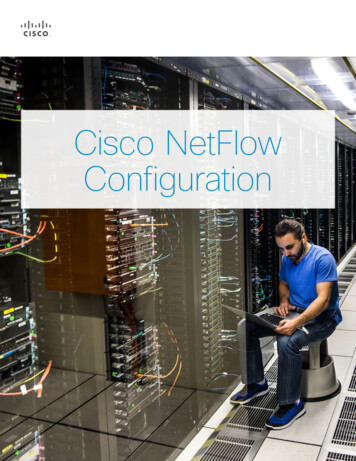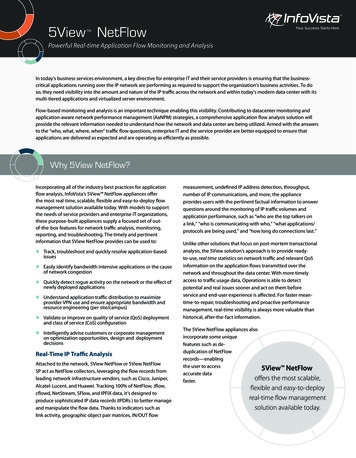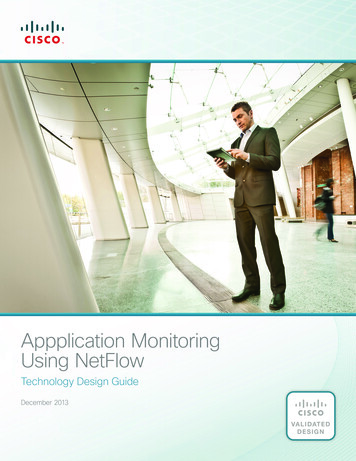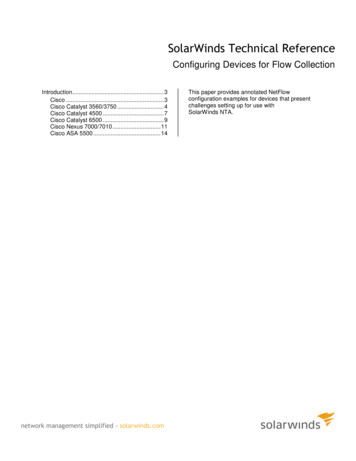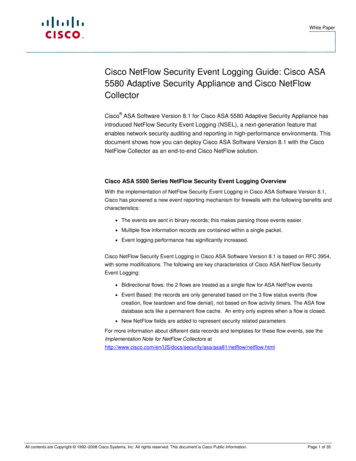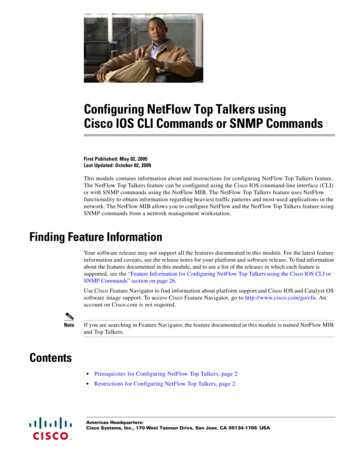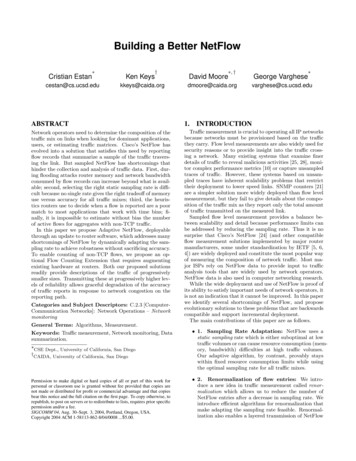
Transcription
Building a Better NetFlowCristian Estan cestan@cs.ucsd.eduKen Keys†kkeys@caida.orgDavid Moore , †dmoore@caida.orgGeorge Varghese varghese@cs.ucsd.eduABSTRACT1.Network operators need to determine the composition of thetraffic mix on links when looking for dominant applications,users, or estimating traffic matrices. Cisco’s NetFlow hasevolved into a solution that satisfies this need by reportingflow records that summarize a sample of the traffic traversing the link. But sampled NetFlow has shortcomings thathinder the collection and analysis of traffic data. First, during flooding attacks router memory and network bandwidthconsumed by flow records can increase beyond what is available; second, selecting the right static sampling rate is difficult because no single rate gives the right tradeoff of memoryuse versus accuracy for all traffic mixes; third, the heuristics routers use to decide when a flow is reported are a poormatch to most applications that work with time bins; finally, it is impossible to estimate without bias the numberof active flows for aggregates with non-TCP traffic.In this paper we propose Adaptive NetFlow, deployablethrough an update to router software, which addresses manyshortcomings of NetFlow by dynamically adapting the sampling rate to achieve robustness without sacrificing accuracy.To enable counting of non-TCP flows, we propose an optional Flow Counting Extension that requires augmentingexisting hardware at routers. Both our proposed solutionsreadily provide descriptions of the traffic of progressivelysmaller sizes. Transmitting these at progressively higher levels of reliability allows graceful degradation of the accuracyof traffic reports in response to network congestion on thereporting path.Traffic measurement is crucial to operating all IP networksbecause networks must be provisioned based on the trafficthey carry. Flow level measurements are also widely used forsecurity reasons or to provide insight into the traffic crossing a network. Many existing systems that examine finerdetails of traffic to reveal malicious activities [25, 28], monitor complex performance metrics [10] or capture unsampledtraces of traffic. However, these systems based on unsampled traces have inherent scalability problems that restricttheir deployment to lower speed links. SNMP counters [21]are a simpler solution more widely deployed than flow levelmeasurement, but they fail to give details about the composition of the traffic mix as they report only the total amountof traffic transmitted on the measured link.Sampled flow level measurement provides a balance between scalability and detail because performance limits canbe addressed by reducing the sampling rate. Thus it is nosurprise that Cisco’s NetFlow [24] (and other compatibleflow measurement solutions implemented by major routermanufacturers, some under standardization by IETF [5, 6,4]) are widely deployed and constitute the most popular wayof measuring the composition of network traffic. Most major ISPs rely on NetFlow data to provide input to trafficanalysis tools that are widely used by network operators.NetFlow data is also used in computer networking research.While the wide deployment and use of NetFlow is proof ofits ability to satisfy important needs of network operators, itis not an indication that it cannot be improved. In this paperwe identify several shortcomings of NetFlow, and proposeevolutionary solutions to these problems that are backwardscompatible and support incremental deployment.The main contributions of this paper are as follows.Categories and Subject Descriptors: C.2.3 [ComputerCommunication Networks]: Network Operations – NetworkmonitoringGeneral Terms: Algorithms, Measurement.INTRODUCTION CSE Dept., University of California, San Diego 1. Sampling Rate Adaptation: NetFlow uses astatic sampling rate which is either suboptimal at lowtraffic volumes or can cause resource consumption (memory, bandwidth) difficulties at high traffic volumes.Our adaptive algorithm, by contrast, provably stayswithin fixed resource consumption limits while usingthe optimal sampling rate for all traffic mixes.Permission to make digital or hard copies of all or part of this work forpersonal or classroom use is granted without fee provided that copies arenot made or distributed for profit or commercial advantage and that copiesbear this notice and the full citation on the first page. To copy otherwise, torepublish, to post on servers or to redistribute to lists, requires prior specificpermission and/or a fee.SIGCOMM’04, Aug. 30–Sept. 3, 2004, Portland, Oregon, USA.Copyright 2004 ACM 1-58113-862-8/04/0008 . 5.00. 2. Renormalization of flow entries: We introduce a new idea in traffic measurement called renormalization which allows us to reduce the number ofNetFlow entries after a decrease in sampling rate. Weintroduce efficient algorithms for renormalization thatmake adapting the sampling rate feasible. Renormalization also enables a layered transmission of NetFlowKeywords: Traffic measurement, Network monitoring, Datasummarization.†CAIDA, University of California, San Diego
data that gracefully degrades the accuracy of trafficreports in response to network congestion on the reporting path. 3. Time bins: Most traffic analysis tools dividethe traffic stream into fixed intervals of time that wecall bins. Unfortunately, NetFlow records can spanbins, causing unnecessary complexity and inaccuracyfor traffic analysis. Our Adaptive NetFlow, by contrast, ensures that flow records do not span bins. Thissimple idea is essential in order to provide statisticalguarantees of accuracy after operations such as renormalization and sampling rate adaptation. 4. Accurate flow counting: It is well known thatSampled NetFlow cannot give accurate counts of nonTCP flows. Such counts are important for detectingattacks (e.g., Slammer worm) and scans. While ourprevious contributions require only software changes,we show how a modest and easily implementable hardware addition (which we call the Flow Counting Extension) can give accurate flow counts even for nonTCP flows. Our extension configured to report just8000 entries provides better results even for TCP flowcounts than SYN counting estimators based on NetFlow reports of 64K entries.The organization of this paper is as follows. We providean introduction to NetFlow in Section 1.1 and describe somemajor problems of NetFlow in Section 1.2. We survey related work in Section 1.3. Next, in Section 2 we present ourAdaptive NetFlow (ANF) proposal, which solves many ofNetFlow’s problems (using adaptation, renormalization andtime bins) and is deployable through a simple update to therouter software. In Section 3 we propose an optional FlowCounting Extension (FCE) which solves the problem of getting accurate flow counts for non-TCP flows, but changes tothe router hardware are required. Finally, in Section 4 wepresent our experimental evaluation of ANF and FCE.1.1NetFlowNetFlow [24], first implemented in Cisco routers, is themost widely used flow measurement solution today. It startedas a cache for improving the performance of IP lookups andwas later adapted to flow measurement. Routers runningNetFlow maintain a “flow cache” containing flow recordsthat describe the traffic forwarded by the router. Theseflow records are then exported using unreliable UDP to acomputer that collects, analyzes and archives them.For each router interface, flows are identified by important fields in the packet header: source and destination IPaddress, protocol, source and destination port, and type ofservice byte. The router inserts a new flow record into theflow cache if a packet does not belong to an existing flow.NetFlow uses four rules to decide when a flow has endedwhich then allows the corresponding record to be exported:1) when indicated by TCP flags (FIN or RST), 2) 15 seconds(configurable) after seeing the last packet with a matchingflow ID, 3) 30 minutes (configurable) after the record wascreated (to avoid staleness) and 4) when the flow cache isfull. Besides the fields identifying the flow, each flow recordalso keeps other data such as the number of packets andbytes in the flow and the timestamps of the first and lastpacket. These records allow many kinds of analyses. For example, using the port numbers present in the exported flowRouter line cardDRAMSoftwareLarge numbers of flowrecords generated by DoSattacks can overwhelm theNetFlow cache and thenetwork path used tocollect NetFlow dataNetFlowflow cacheBusProcessorupdatesterminatedflow recordsDatacollectionandanalysisserverSmall buffer1 in Npacket headersForwardinghardwareSampling rate setstatically but optimalsampling rate dependson traffic mixFigure 1: Problems: number of records strongly depends on traffic mix and network operator must setsampling rate. With unfriendly traffic mixes, thenumber of flow records generated by NetFlow increases significantly and this can exhaust the memory at the router and the bandwidth available forreporting the records to the collection station. Setting NetFlow’s sampling rate is hard because theoptimal sampling rate depends on the traffic mix.records, an analyst can produce a breakdown of the traffic byapplication; using the IP addresses, one can produce a traffic breakdown by source or destination [27]. By combiningdata from multiple routers one can obtain a network-wideview of the traffic demands of the ISP’s customers [16].To update the NetFlow cache when a packet is seen, NetFlow must look up the corresponding entry in the flow cache(creating a new entry if necessary) and update that entry’scounters and timestamps. Since for high speed interfaces,the processor and the memory holding the flow cache cannot keep up with the packet rate, Cisco introduced sampledNetFlow [29] which updates the flow cache only for sampledpackets. For a configurable value of a parameter N , one ofevery N packets is sampled. When using sampled NetFlowrecords analysts compensate for the sampling by multiplyingrecorded values by N , the inverse of the sampling rate.1.2Problems with NetFlowEven though it is widely used, NetFlow has problems. Inthis paper we identify and address four of them. Number of records strongly depends on traffic mix. A larger than expected number of recordscan overwhelm the router and the network path to thecollection station, as illustrated by Figure 1. Today’straffic mixes often include massive flooding denial ofservice attacks or aggressive port and IP scans thatgenerate a large number of “flows” consisting of a single small packet. The number of entries exported under these circumstances is very large, and the trafficthey generate can cause the network to drop packets. Duffield and Lund show [11] that the errors in-
ProblemNumber of records strongly depends on traffic mix (Figure 1)Network operator must set sampling rate (Figure 1)Mismatch between flow termination heuristics and analysis (Figure 2)Cannot estimate the number of flows (Figure 3)SolutionAdapting sampling rateto traffic (Section 2.2)Measurement bins (Section 2.1)Sampling flows (Section 3)Requirementsoftware updatesoftware updatehardware additionTable 1: Summary of NetFlow problems and proposed solutions.Sampling decisionsT T N C F C T T F H F F P H L P L H K P K H R KSampled packetsflowID N,Pkts 3NetFlow recordsflowID F,Pkts 4T,2T,2L,2Sampling probability 1/6Flow cache 1C 1Traffic mix 1N N C C F F T T H H J J P P L L A A2 packet flowsflowID K,Pkts 3flowID H,Pkts 4C,2flowID P,Pkts 3Traffic mix 21 packet flows N M C D F E T U H G J IR,2P R L K A BAnalysis binstime (min)5678Figure 2: Problem: mismatch between flow termination heuristics and analysis. The heuristics usedby NetFlow to terminate flow records do not matchthe time bin model used by traffic analysis. For flowrecords that span multiple bins, the analysis application has to estimate how many of the packetsreported belong to each bin. While assuming thepackets were uniformly distributed can give goodresults as for flow record H it often produces inaccurate ones as for flow F.troduced by lost NetFlow packets are worse than theerrors introduced by various types of intentional sampling within the measurement infrastructure. To solvethis problem we propose in Section 2.2 adapting thesampling rate to the traffic mix. Network operator must set sampling rate. Setting the sampling rate involves tradeoffs. The lowerthe sampling rate, the fewer the packets that are sampled. This reduces the load of the processor runningNetFlow and the strain on router memory and on thenetwork used to export the flow records. But a lowersampling rate also means larger errors in traffic measurement and analysis. The sampling rate constitutingthe best compromise between these two opposing considerations depends on the traffic mix: when the trafficis low we want a higher sampling rate to obtain betteraccuracy, while when the volume of the traffic is highand when massive attacks are in progress we need alower sampling rate to protect the measurement infrastructure. Setting the static sampling rate is a harddecision for the network operator. To spare operatorsthis dilemma we propose adapting the sampling rateto the traffic mix in Section 2.2. Mismatch between flow termination heuristicsand analysis. Traffic analysis and visualization [16,27, 3, 1, 19] groups traffic into time intervals usually referred to as “bins”. The size of these bins ranges fromminutes to days and most often one analyzes manyconsecutive bins of the same size. If the timestampsindicating the start and the end of the NetFlow recordare within a single bin, all the packets of the flow areAnalysis question: How many flows are there?Answer must be wrong for one of the two traffic mixes.J 1P 1Flow cache 2C 1I1R 1Figure 3: Problem: cannot estimate the numberof flows Assume we want to estimate the numberof flows in these two traffic mixes with the samenumber of packets and identical sampling decisions.Note that the first mix contains 2 packet flows andthe second one twice as many 1 packet flows. Bothflow caches contain three flow records and each hasa packet count of 1, so whatever estimator we use wewill get the same answer for both cases. It will besignificantly off for at least one of the traffic mixes.counted against that bin and processing is simple. Onthe other hand if the flow starts in one bin and finishes in another, one needs to estimate how much ofthe traffic belonging to the flow went to each bin. Thiscomplicates processing and introduces inaccuracies, asshown in Figure 2. Furthermore, interactions betweensampling and the flow termination heuristics can leadto flow splitting such as for flow T in Figure 2 which increases the number of times the flow is reported [11]:because NetFlow only sees the sampled packets, thetime between consecutive packets can increase to morethan the “inactive timer” (15 seconds by default) andNetFlow terminates the record prematurely and reports fragments of the flow separately. To solve thisproblem we propose in Section 2.1 adopting a binnedmodel for NetFlow. Cannot estimate the number of flows. Large increases in the number of flows are telltale signs of denial of service attacks, scans, and worms which aremuch easier to notice when the traffic is measured inflows as opposed to bytes or packets [27]. Withouthelp from the underlying protocols, it is impossible torecover the number of flows in the original traffic fromthe collected data [8]. Figure 3 illustrates the inherent error when trying to estimate the number of flows.Both traffic mixes have the same number of packetsand go through the same sampling process. They produce similar flow caches: both have three entries, eachwith a packet counter of one. Any estimator working with these flow caches would give the same estimate for both traffic mixes, but in at least one of the
cases the result will be significantly off since the second mix contains twice as many flows as the first one.We note here that the actual problem we want to solveis not counting the total number of flows but the related problem of counting the number of flows withinspecific aggregates (e.g., the number of SMTP flows,the number of flows coming from an IP address suspected of being a spam relay, etc.) There are goodsolutions for counting TCP flows since the first packetof each flow has the SYN flag set, which is recordedwhen present in the packets sampled by NetFlow [12]and our Adaptive NetFlow. Counting UDP and ICMPflows is equally important as these protocols are usedfor scanning, probing and spreading by worms such asSlammer [23] and Blaster and by malicious hackers.To solve this problem we propose in Section 3 the optional addition of new hardware that implements ourFlow Counting Extension.1.3Related workWhile sampling can be compensated for in reports thatmeasure the traffic in packets or bytes it has been proven [8]that it is impossible to measure traffic in flows without bias.Duffield et al. [12] elegantly sidestep this impossibility result by using protocol level information present in the NetFlow records: they use the number of flow records with theTCP SYN flag set to accurately estimate TCP flows. Wepropose an optional flow counting extension which worksfor non-TCP traffic as well. In [13], Duffield et al developestimators for flow length distributions and techniques forscaling measurements of sampled flow data. All of thesetechniques continue to be valuable and perform similarlyunder our Adaptive NetFlow.There are solutions for counting the number of flows atline speeds [15], but these count the total number of flows,and one cannot later recover the number of flows associatedwith specific aggregates of traffic out of the overall mix. Ourflow counting extension allows arbitrary aggregation of theflow keys in post-processing to obtain estimates of the flowsin those aggregates.Our flow counting extension is related to flow samplingintroduced by Hohn and Veitch [18]. Important differencesbetween FCE and their flow sampling are that we also outline a hardware implementation that can work at line speedsand that our primary focus is estimating the number of flowsin arbitrary aggregates of traffic whereas theirs is computingthe distribution of flow sizes. Choi et al. use adaptive sampling [9] to guarantee that the variance introduced by thevariability of packet sizes does not exceed a pre-set limit.There are solutions such as sFlow [26] that sample packets,but do not build flow records at all. The great advantage ofthese types of solutions is that they report full packet headers together with a portion of the packet payload and thisprovides much richer raw data for analysis. The disadvantage is that they do not benefit of the compression achievedby flow records that count more than one packet.2.ADAPTIVE NETFLOWAdaptive NetFlow is an improved version of NetFlow thataddresses the shortcomings discussed in Section 1.2, mostlywithout changes to the router hardware or the infrastructure collecting traffic measurement data. Section 2.1 describes how we solve the mismatch between analysis and theflow termination heuristics of NetFlow by simply terminating flows only at the end of measurement bins. We eliminatethe variability of the size of reported NetFlow data and solvethe problems associated with the operator having to set thesampling rate by automatically adapting the sampling rateto the traffic mix (Section 2.2). When adapting the sampling rate ANF occasionally decreases the sampling rate toavoid filling all available memory. In order to keep the finalresults consistent with the new sampling rate, we need toadjust the packet and byte counters of the existing entries.We describe how we efficiently perform this “renormalization” in Section 2.2.1. If an entry’s packet counter reacheszero during renormalization, meaning that none of its packets would have been sampled at the new sampling rate, thatentry is deallocated. To ensure that ANF never runs outof memory, renormalization must free a certain number ofentries. In Section 2.2.2 we describe the efficient and accurate method used by ANF to find the new sampling ratethat ensures that the required number of entries are freed.In Section 2.3 we give an example of how a router manufacturer could configure ANF to ensure that router memoryand processing power are not exhausted under any possibletraffic mix.Many proofs of the lemmas presented in this section areomitted for brevity. They can be found in the technicalreport version of this paper [14].2.1Operation in measurement binsIt is easiest to first address the mismatch between the NetFlow’s flow termination heuristics and the analysis based ontime bins used by applications. We can simplify processingof NetFlow data if all flow records reported fit within thebin used in analysis. We divide the NetFlow operation intoshort bins so that the bins used by traffic analysis are exactmultiples of the measurement bins. We do not terminateflow records during the measurement bins, but terminate allactive flow records at the end of the bin. To correctly placeflow records in analysis bins, the analysis application needsto know only to which measurement bin it belongs. Thetimestamps of the first and last packet in flow records areno longer necessary, but they can be retained for backwardcompatibility. Alignment between measurement and analysis bins is not a problem if routers have accurate clocks, oruse solutions such as the Network Time Protocol [22] to keeptheir clocks from drifting. Due to binning and to changes ofsampling rate during the operation of ANF, the timestampsin the flow records cannot be used directly to derive flowlength information. While flow length information mightbe derived indirectly, flow length statistics are outside thescope of this paper.The size of measurement bins is a compromise betweentwo opposing considerations. Larger measurement bins reduce the traffic generated by NetFlow since records are reported less often. On the other hand measurement bins mustbe at least as small as the smallest analysis bins, and smallerbins mean prompter reporting of network traffic. Choosingthe bin size involves the same tradeoffs as choosing the active timeout that controls how long the entry of an activeflow stays before being terminated and reported by Cisco’sNetFlow to avoid staleness (default 30 minutes). Anecdotalevidence suggests that network operators often decrease theactive timeout to obtain prompter reporting [2]. We conclude that the size of the measurement bin will have to be a
1000Memory usage (thousands of entries)Sampling rate (log scale)9000.01Adaptive NetFlowSampled NetFlow800Adaptive NetFlowSampled NetFlow700600500400300200Figure 4: ANF automatically chooses a lower sampling rate during a DoS attack. While NetFlow’ssampling rate stays constant during a DoS attack,our Adaptive NetFlow switches to a lower samplingrate during each bin spanning the attack to keep thenumber of flow records generated constant. At thestart of each new bin the rate is reset to the maximum, so that when the attack ends the rate is notkept unnecessarily low.configurable parameter in Adaptive NetFlow. We considerthat one minute and five minutes are both good choices forthe default measurement bin size. In our experiments weused the more challenging one minute size for the measurement bins.2.2Adapting the sampling rateIdentifying the optimal sampling rate for NetFlow is hardbecause there are many conflicting factors to consider. Oneof them is avoiding overloading the processor that performsthe NetFlow processing, whether it is the router CPU or aprocessor on a line card. The network operators must usetrial and error to find the rate the router can support. Instead we propose that the router manufacturer determinesthe maximum sampling rate at which the processor can operate under worst case conditions. This traffic mix couldoccur for example due to a massive distributed denial ofservice attack.1 We use this as the maximum sampling rateand we initialize the sampling rate to this value at the beginning of each bin.Even if we start with a sampling rate low enough to notoverwhelm the processor, the number of entries created canexceed the amount of available memory. With most trafficmixes, the number of entries created during a one minute1Since this is a very unlikely scenario, especially for fastbackbone links, in actual practice Adaptive NetFlow willnever use more than a small percentage of the processor.Even if the router receives this unfavorable traffic mix due toa massive flooding attack, ANF will keep the processor fullyloaded only for a short time until it decreases the samplingrate in response to the memory being consumed.Sixth bin endsFifth bin endsDoS endsFourth bin endsThird bin endsSecond bin endsDoS startsFirst bin endsFirst bin starts0TimeFigure 5: ANF limits memory usage during a DoSattack. While NetFlow’s memory consumption increases during a DoS attack our Adaptive NetFlowkeeps its memory usage bounded.measurement bin with the highest sampling rate the processor can support exceeds the tens to hundreds of megabytesof memory typically reserved for flow records. Instead ofchoosing the sampling rate in advance, ANF dynamicallydecreases the sampling rate until it is low enough for theflow records to fit into memory. Figure 4 shows how thisprocess finds different sampling rates for normal traffic andfor a DoS attack.Traffic analysis multiplies the measured traffic by the inverse of the sampling rate to estimate the actual traffic,but if we keep changing the sampling rate while the flowrecords count the traffic, it is hard to determine what sampling rate to use as a basis for this compensation duringanalysis. To avoid this problem, we need to renormalizeexisting flow entries when we decrease the sampling rate.The renormalization process is equivalent to stopping theoperation of NetFlow and going through all records to adjust the byte and packet counters to reflect the values theywould have had if the new sampling rate had been in effectfrom the start of the bin. This way traffic analysis needsto know only the final sampling rate. Renormalization alsoremoves the flow entries for which no packets would havebeen sampled with the new sampling rate. By freeing entries, renormalization ensures that there is enough memoryto accommodate the records of new flows that appear untilthe end of the bin. Figure 5 illustrates how this effectivelycaps the memory usage during a DoS attack. The actualrenormalization used by ANF does not require NetFlow tostop its operation, but operates concurrently. Section 2.2.1gives a detailed description of how our efficient renormalization works and Section 2.2.2 explains how we use efficientand exact computations of the number of entries removedto find the new sampling rate that guarantees that renormalization removes enough entries to keep the memory fromever filling.Seventh bin endsTimeSeventh bin endsSixth bin endsFifth bin endsDoS endsFourth bin endsThird bin endsSecond bin endsDoS startsFirst bin startsFirst bin ends1000.001
If the actual sampling rate is dynamic, one cannot ensurethat it is the same for all routers nor even for different timebins at the same router. This does not cause problems withcombining data from different bins or from multiple sources(e.g. combining the 60 one minute bins to get the trafficfor the whole hour, or combining the traffic of many routersto get the traffic of a PoP) because we can simply add thecounters from the flow records after having divided them bythe respective sampling rates.By adapting the sampling rate we ensure that ANF generates a fixed number of flow records. It is useful to quantifythe accuracy of the analysis results one can obtain from afixed number of records. Lemma 1 shows that, when estimating packets and bytes in arbitrary traffic aggregates thatconstitute a certain fraction of the total traffic, the worstcase relative standard deviation depends only on the number of entries and not on the speed of the link. More simplyput this means that you can slice and dice the data in anyway, and as long as your slices are no smaller than a certainpercentage of the pie, the relative errors of the estimates aresmall. For example, let’s say we use a sampling rate thatproduces 100,000 flow entries, and network A accounts for10% of the total packets, we will be able to measure its traffic with a relative standard deviation of at most 1%. If itaccounts for 10% of the bytes, while the average packet sizeis 400 bytes and the maximum size 1500, we will be able tomeasure its traffic with an average relative standard deviation of at most 1.94% (irrespective of the size of the packetsof network A).Lemma 1. From the NetFlow records produced with independent random sampling at a rate at which the expectednumber of flow records is M , we can estimate the traffic ofany aggregate amounting to a fraction f of the ptotal traffic with a relative standard deviation of at most 1/(M f )pfor the number of packets and at most smax /(savg M f ) psmax /(smin M f ) for the number of bytes where smin , savgand smax are the minimum, average and maximum packetsizes.Proof Let T be the total number of packets sent duringthe measurement interval. With a sampling rate of M/T ,the expected number of packets is M , and the expected number of entries is at most M . Thus the sampling rate at whichthe expected number of entries is M will be p M/T . Thenumber of packets in the aggregate is f T , and the number of those sampled has a binomial distribution with meanpf T and variance p(1 p)f T . Since we get the estimatefor the number of packets in the aggregates by multiplyingthe number of sampled packets by 1/p, the variance of theestimate will be (1/p2 )p(1 p)f T (1 p)f T /p f T /p f T /(M/T ) f T 2 /M . Thep standard deviation of this esf /M andtimate will be at mostTpp its relative standarddeviation a
NetFlow cache and the network path used to collect NetFlow data Sampling rate set statically but optimal sampling rate depends Figure 1: Problems: number of records str ongly de-pends on traffic mix and network operator must set sampling rate. With unfriendly traffic mixes, the number of flow records generated by NetFlow in-
